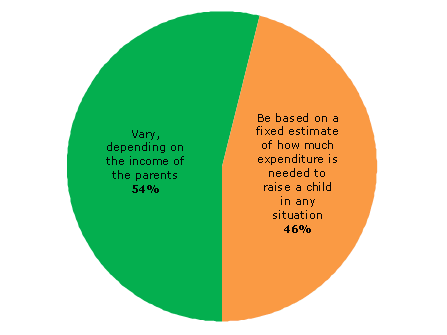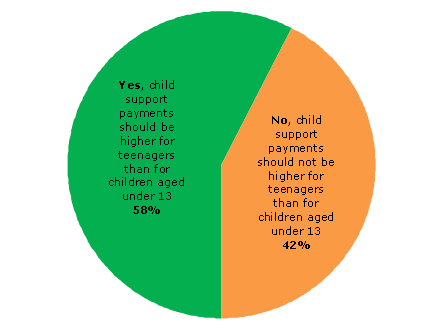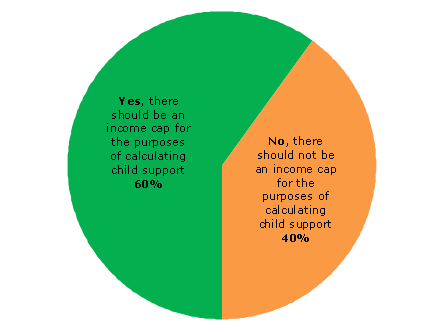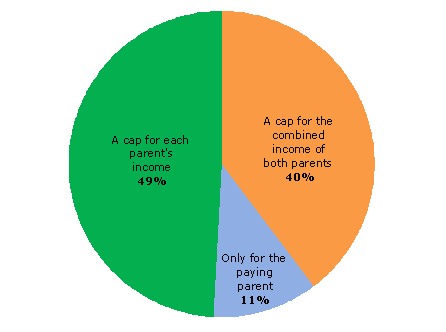Chapter 2 - Expenditure for raising children
Under the estimates of expenditure for raising children in New Zealand outlined in the discussion document, child support payments would, under a revised formula, continue to increase in line with parental income to reflect the fact that people with higher incomes generally spend more on their children. A cap on parental income for child support purposes would also be retained.
Since the recent research undertaken indicates that raising teenagers is more expensive than raising younger children, a revised formula could recognise two main age categories – 0 to 12 years and over 12 years (as well as a mixed age category).
Results of online consultation
Q1: Do you think that child support payments should:
- vary, depending on the income of the parents?
or - be based on a fixed estimate of how much expenditure is needed to raise a child in any situation?

Q2: Do you think child support payments should be higher for teenagers than for children aged under 13?

Note: The view that child support payments should be higher for teenagers than for children under 13 was particularly prominent amongst receiving parents, with 79% believing payments should be higher for teenagers, compared with 36% of paying parents.
Q3: Do you think there should be an income cap for the purposes of calculating child support payments?

Note: The view that there should be an income cap for the purposes of calculating child support payments was particularly prominent amongst paying parents, with 87% believing there should be a cap, compared with 32% of receiving parents.
Q3(a): If you think there should be an income cap, what do you think the income cap should be?

Summary of comments on expenditure for raising children
Estimated expenditures
The majority of responses supported the view that child support payments should vary depending on the income of the parents. However, a significant number also supported the view that payments should instead be based on a fixed estimate of how much it costs to raise a child. For those that held the latter view, some felt that this would offer parents the opportunity to make more discretionary contributions.
Commenting on using up-to-date information on the expenditure for raising children (in particular, using the “expenditure for raising children chart” provided in the discussion document)[1] in a revised child support formula, some submitters felt that the figures were either too high or too low. Several submissions noted the often high costs involved with maintaining contact with children, particularly when they lived in different locations. Also, there was concern that the types of expenditure used to compare households with equivalent living standards did not adequately reflect the variety of households’ lifestyles and how these might vary.
Some submitters also asked for clarification on the methodologies used in calculating the estimated expenditure figures, and how the calculations might interact with other Government payments. They recommended that welfare payouts such as Working for Families received by parents should be included when calculating income for child support purposes. On a similar theme, one submission suggested that while tax credits were taken into account in the expenditure on children calculation, who received those tax credits was not adequately taken into account when apportioning the expenditure between the two parents, as the receiving parent generally receives the credits as they are the primary caregiver.
Child support varying depending on the age of children
There was general agreement with the proposition that expenditure on teenagers was higher than for younger children. A number of comments, however, suggested that child support payments should be higher for children under 5 – owing mostly to costs associated with childcare for younger children, or alternatively owing to lost work opportunities in caring for the children directly. Some submitters therefore called for three different age brackets to be introduced.
An income cap
Many comments supported the retention of an income cap, reflecting the fact the additional spending becomes more discretionary as income increases. It was also noted that having a cap means that parents still have the incentive to earn extra income without fear that this will be taken into account for child support purposes.
Other themes noted
Some expressed concern that the paying parent often had no say in how child support payments are used by the receiving parent and that funds intended for the child could be diverted to the caregiver. On the other hand, many receiving (as well as some paying) parents commented that they often bear the vast majority of the costs in raising a child, and that this is not reflected in the child support payments they receive or are entitled to receive.
Some suggested that the child support scheme can result in power and control heavily favouring one parent at the expense of the other. This perceived imbalance appears to have a significant effect on the relationship between the parents and, in some cases, a child’s relationships with his or her parents. Some submissions indicated that, as a default position, the amount of child support being assessed by the formula should be halved, leaving the rest as a mix of discretion, voluntary contribution and cooperation between the parents.
Other responses included:
- that the income of the family unit (when either parent has re-partnered) should be taken into account. Also, many paying parents (and their family members) felt that children from a new relationship are not sufficiently taken into account when calculating child support payments; and
- a recurring concern about the perceived ability of paying parents who are self-employed to manipulate their income for child support purposes in order to minimise payments.
Comments on expenditure for raising children[2]
Estimated expenditures
“The objective should be, insofar as it is possible, to afford the child the level of financial security they would otherwise have enjoyed had the relationship of their parents continued harmoniously. Consequently, fixed estimates of expenditure may drastically over- or under-estimate the level of expenditure that is required. Furthermore, any such determination would have to be made by the State.”
“Support the comments about the costs the non-custodial parent has – eg, small children can share a bedroom but teenage boy and girl each need own bedrooms when staying with non-custodial parent. Children’s income should be congruent with the lifestyle of the parents, ie high income with high income parents otherwise they are socially economically dislocated from parent; reinforces that both parents have an obligation to support their children.”
“Child Support should be based on how much it costs to raise a child of a set age with each parent contributing their amount based on time spent with children and who is responsible for costs.”
“I believe costs do change/increase with the age of children but payment should be assessed on that and not how much the paying parent earns.”
“I pay child support, I also pay for school fees, clothing, piano lessons, doctors fees, sport fees etc. As I am the only responsible working parent these payments should be taken into account when calculating child support payments.”
“The parent that raises the child most of the time will always be paying more therefore their income should not be included in any child support formula.”
“The child support system proposed attempts to treat the parents as if they are still together allocating income earned by both to support their children. In some situations IR pays Working for Families tax credits to parents raising children. The amount of child support payable to be allocated between the paying and receiving parents should be reduced by the amount of Working for Families tax credit received by the receiving parent.”
“It is essential that the true cost of raising a child is factored into the support payments so that paying parents are paying for the child only and not the receiving parent’s lifestyle.”
“This assumes that both parents pay equally for the cost of raising children. Under many “shared care” arrangements including my own, the non-custodial parent makes no (not a single $) contribution to any costs like school fees, uniforms, clothing, sports, hobbies, holiday care, after-school care, books, presents, doctor visits etc. How will this formula encourage shared costs?”
“Your cost of raising a child estimates are too high.”
“The current system is flawed in that the paying parent has no say in how the receiving parent spends the child support money. This money should only be spent on essentials for the child/children.”
“While it is important to think about the over-arching costs of raising a child, the determination should also include who is actually paying the costs. In a perfect world both parents would contribute equally to the costs, but in my situation the non-custodial is assessed to pay the minimum and expects me to pay for everything, including the costs of access visits.”
“You can use the fixed expenditure. Some people just wouldn’t be able to afford it.”
Child support varying depending on the age of children
“The payments should be a fixed estimate providing it takes into consideration who is doing the caring and paying of expenses for the child/ren. Single parents like myself should not have our income included as the paying parent does not contribute to the expenses. The expenditure costs for a teenager increases and the payments should reflect that. There should be no income cap because those in high incomes would be able to provide [the] same opportunities as those who remain married.”
“I think that one of the most expensive age brackets is actually under 5, as babies need nappies, if they are in child care this often can cost a lot, and if you are unable to breastfeed you have to buy formula. I think that the cost of infants is often forgotten or underestimated.”
“3 AGE BRACKETS PLEASE! A bracket for children 0-5 and 5-12 years as well as children over 12. Once children start school the expenses increase considerably once the child requires school uniforms annually (kids 5-12 grow very quickly, requiring shoes and clothes far more often). Once a child is school age, they have costs for food, school lunches, school trips, sports etc. They are more expensive again than preschoolers.”
“I think under-5s are equally as expensive as over 13s, ie childcare costs, rate of physical/developmental growth and meeting associated needs, etc. I think where one parent is the primary caregiver it is not a full “shared care” arrangement/the caregiving parent's income should not be relevant for child support purposes as it's naturally distorted/different from that parent's true earning potential/there are opportunity costs/long-term career impacts for parents choosing to work part-time at home.”
“I'm not sure about how much more expensive it is to raise teenagers. On a basic level it is more expensive, however if both parents work (and don't qualify for childcare allowances) the cost of fulltime childcare can exceed $300 per week.”
An income cap
“Having a realistic cap means that the contributing parent can work hard, get promotions, work overtime or generate any extra income without the fear that that extra income will simply be lost to Child Support. When I say realistic I mean that child support should never be calculated on more than twice the average wage.”
Other comments
“The expenditure should be based on the real cost of raising a child in whatever circumstances they live – ie, if they live with a mother who is married to a new partner and raising children in a shared environment, then the combined income of the new family should be taken into account.”
“What is not recognised in this formula is other dependants: the chart should not discriminate between your spend on a child living with an ex partner (for whom you pay child support) to children/ dependants you provide for post this relationship. The current system is divisive and one-sided, as a result it creates deep resentment not necessarily from the paying parent but from other family members that quite rightly recognise an unfair and unjust system.”
“Self-employed and business persons’ income should be assessed by a govt-approved accountant. Currently evidence of income is provided by [a] person’s own accountant and in my experience – very much down-scaled.”
1 See page 46 of the discussion document.
2 These comments, and those that follow in this report, are representative examples of comments received in the online submission and written submissions. Apart from where indicated by square brackets they are represented verbatim.


